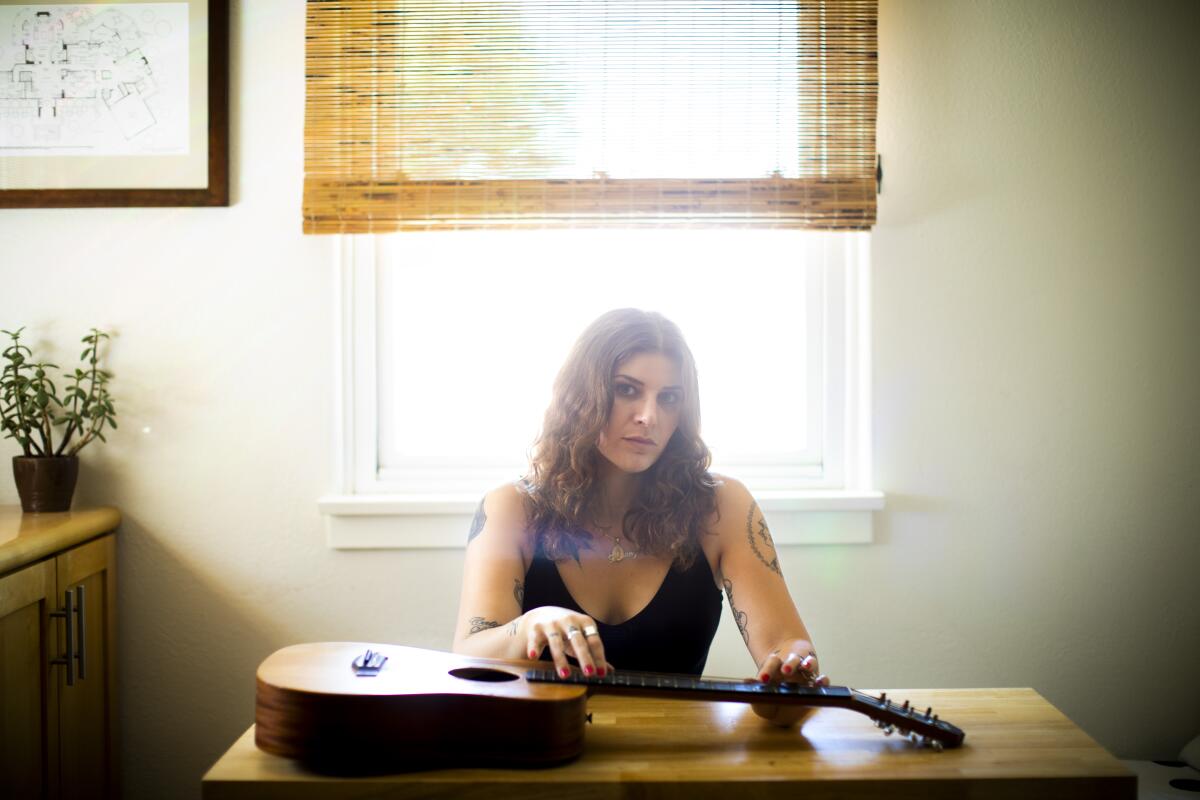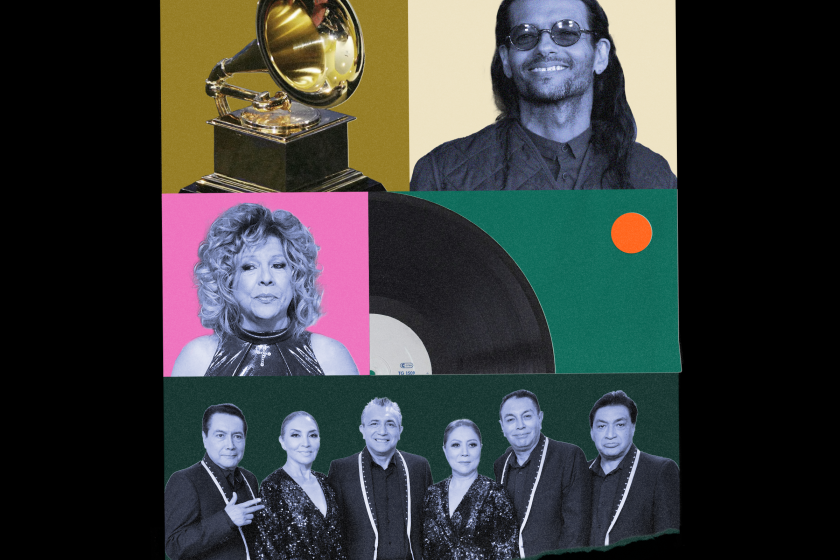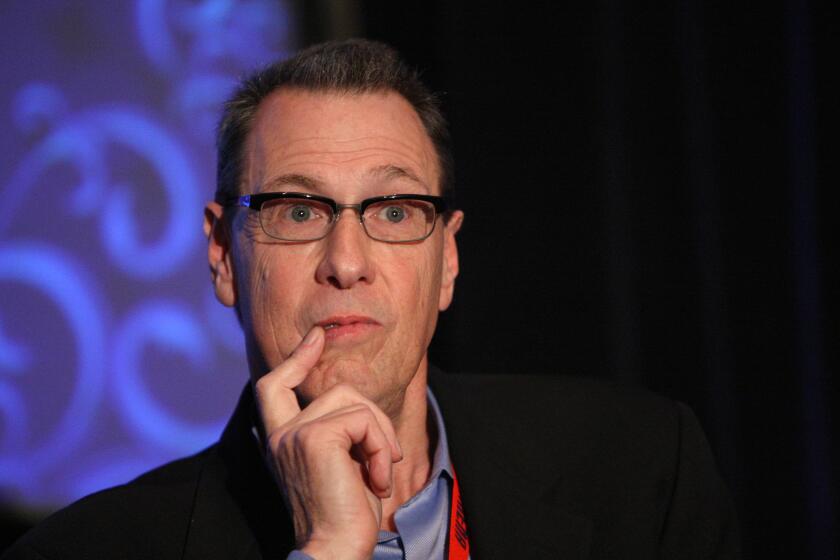Behind the Story: 50 songs for a New Los Angeles

In 1923, prominent Los Angeles music booster Artie Mason Carter, known as the “mother of the Hollywood Bowl,” made a grand declaration on the city’s future: “It is impossible to sing and frown, and there is no better way of molding this city, with its continuous influx of strangers, into one solid mass of fine citizenship, than through community singing.”
Mrs. J.J. Carter, as she was called in this paper during the 1920s, may have been wrong about the ability to sing and frown — she was unaware that mumble rap and death metal were in our future — but nearly a century later, her idea of shaping a city through music is compelling. So many songwriters have planted stories in L.A. neighborhoods and intersections we drive through daily that it’s hard to keep up with the volume.
Whether as Bob Seger’s action-movie rocker “Hollywood Nights” or San Pedro singer and songwriter Miguel’s more romantic retelling in a song of the same name, this accumulation of geo-located lyrics is embedded in our narrative landscape. It’s in Becky G’s Randy’s Donuts reference in “Becky From the Block” and 2Pac’s “To Live and Die in L.A.” line, “Remember KDAY? Weekends, Crenshaw, MLK?”
Some write about L.A. because it’s what they know. Others project the dreams of a migrating nation into the musical charter. They do it to be cool or to prove they understand the city.
These constantly evolving ways of seeing and hearing Los Angeles generated the seed of the idea that became the “50 Songs for a New L.A.” project. It’s the third in a series I started in 2017 with an exploration of Sunset Boulevard and music. In 2018, Times data and graphic journalist Priya Krishnakumar and I followed that with a deep dive into Rosecrans Avenue in South Los Angeles. Considered rap’s main street, Rosecrans has been the setting for dozens of songs for seminal artists including 2Pac, Kendrick Lamar, YG, Snoop and DJ Quik.
But for this project, we decided to pull back and look at Los Angeles as whole, and then focus on songs that mention specific neighborhoods, townships, streets and buildings. One history of the city, after all, can be tracked by an ever-expanding data set that contains every instance in which lyricists have represented its neighborhoods and streets, shuttered businesses and vanished orange groves in song. Each lyrical reference becomes a geo-locatable map point, another dot on an ever-expanding song cycle.
“You’ve got neighborhoods where entire genres dwell and exist,” singer-songwriter Devendra Banhart said when discussing the project. “Like hair metal. There’s a hair metal section of L.A., still.”
Priya and I brainstormed many ways to attack this question. For a few months, I scoured lyric site Genius, pored through books on Los Angeles music history and put out calls on social media asking for references. I input data on lyrics to about 500 songs a spreadsheet. But as I was doing this, an editor asked a basic question on this increasingly unwieldy data set: “What are you trying to say in this project?”
Other than, “Gosh, there are a lot of songs about this place,” I didn’t have a good answer. Eventually, though, we came up with a few questions worthy of exploring: How does the world hear contemporary Los Angeles? How do songwriters craft memorable work about this place?
To answer the latter question, I spoke with musicians Banhart, Schoolboy Q, St. Vincent, Courtney Love, Jhené Aiko, Phoebe Bridgers, Best Coast’s Bethany Cosentino, Dawes’ Taylor Goldsmith, Los Abandoned’s María del Pilar, David Gaston Green and others to hear them tell origin stories on their songs.
The documentary “Los Angeles Plays Itself” explores the city one movie scene at a time. Ed Ruscha’s “Sunset Strip” photo series locked into history the storefronts of 1966. Here, we look at the ways individual songs have come to define the city over the last quarter century. From our massive spreadsheet, we curated this collection of 50 songs that paint a panoramic portrait of Los Angeles in the 21st century.
What is the sound of 21st century L.A.? Writer Josh Kun described it in his essential essay “Los Angeles Is Singing” as a kind of unfurling score, one that “opens up into a centuries-long songbook of local odes and regional hymns and three-minute GPS pop-songs that come to life at full volume.”
“Song Writer Believes Local Future Brilliant,” read a 1922 headline in The Times. “Los Angeles, within a very short time, will be the principal center of musical influence in the United States,” songwriter Henry R. Cohen said in advance of a performance at Grauman’s Theatre.
Cohen’s evidence: “There has never been a musical success scoring in Los Angeles that hasn’t won its way in New York and elsewhere throughout this entire country. In other words, if the song is good enough for Los Angeles it is good enough for the whole world.”
The tattered lives of a million failed songwriting careers confirms that’s no longer true, if it ever was. But the sentiment remains. Those who successfully represent a city’s psyche become part of its DNA.
More to Read
The biggest entertainment stories
Get our big stories about Hollywood, film, television, music, arts, culture and more right in your inbox as soon as they publish.
You may occasionally receive promotional content from the Los Angeles Times.







